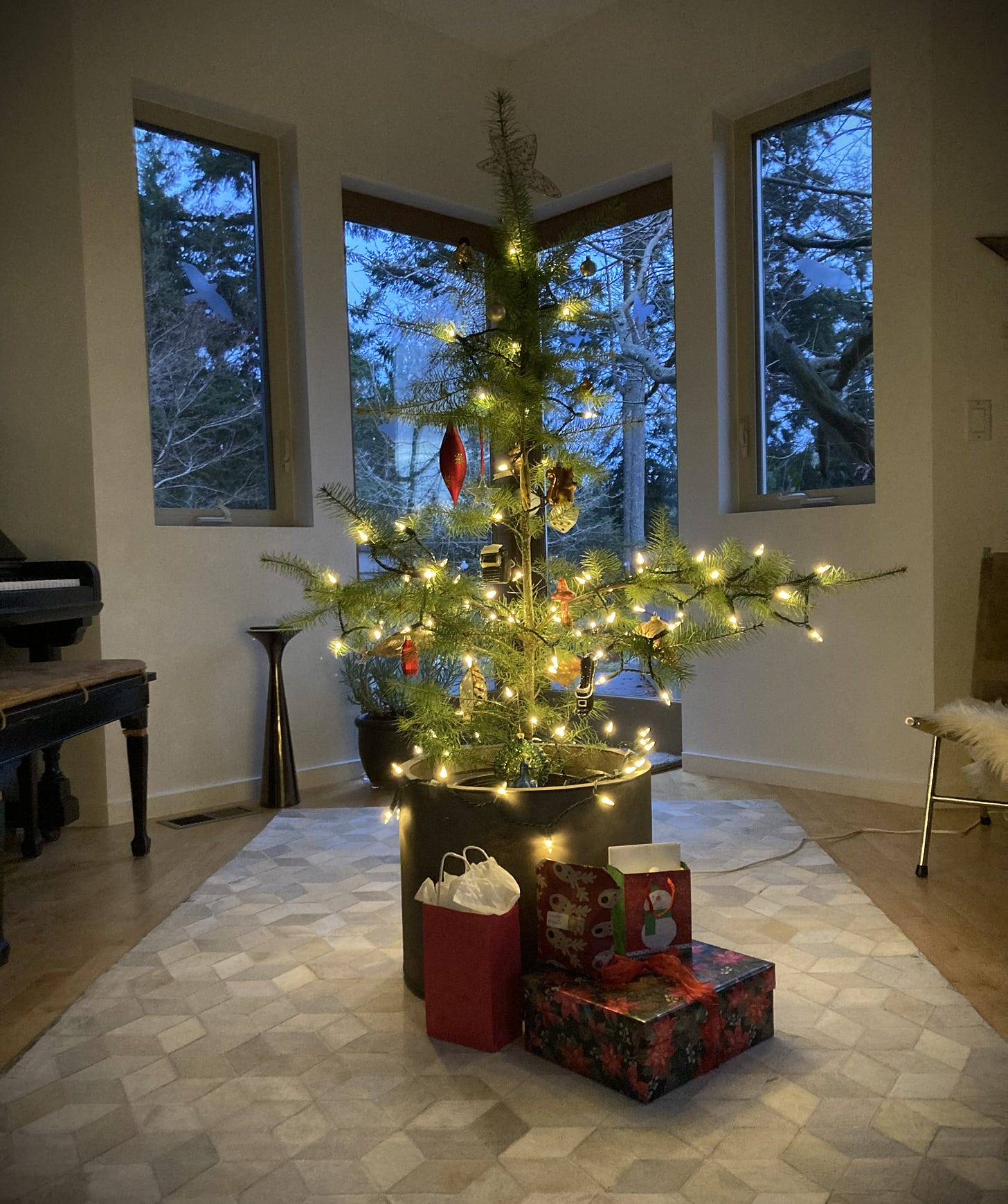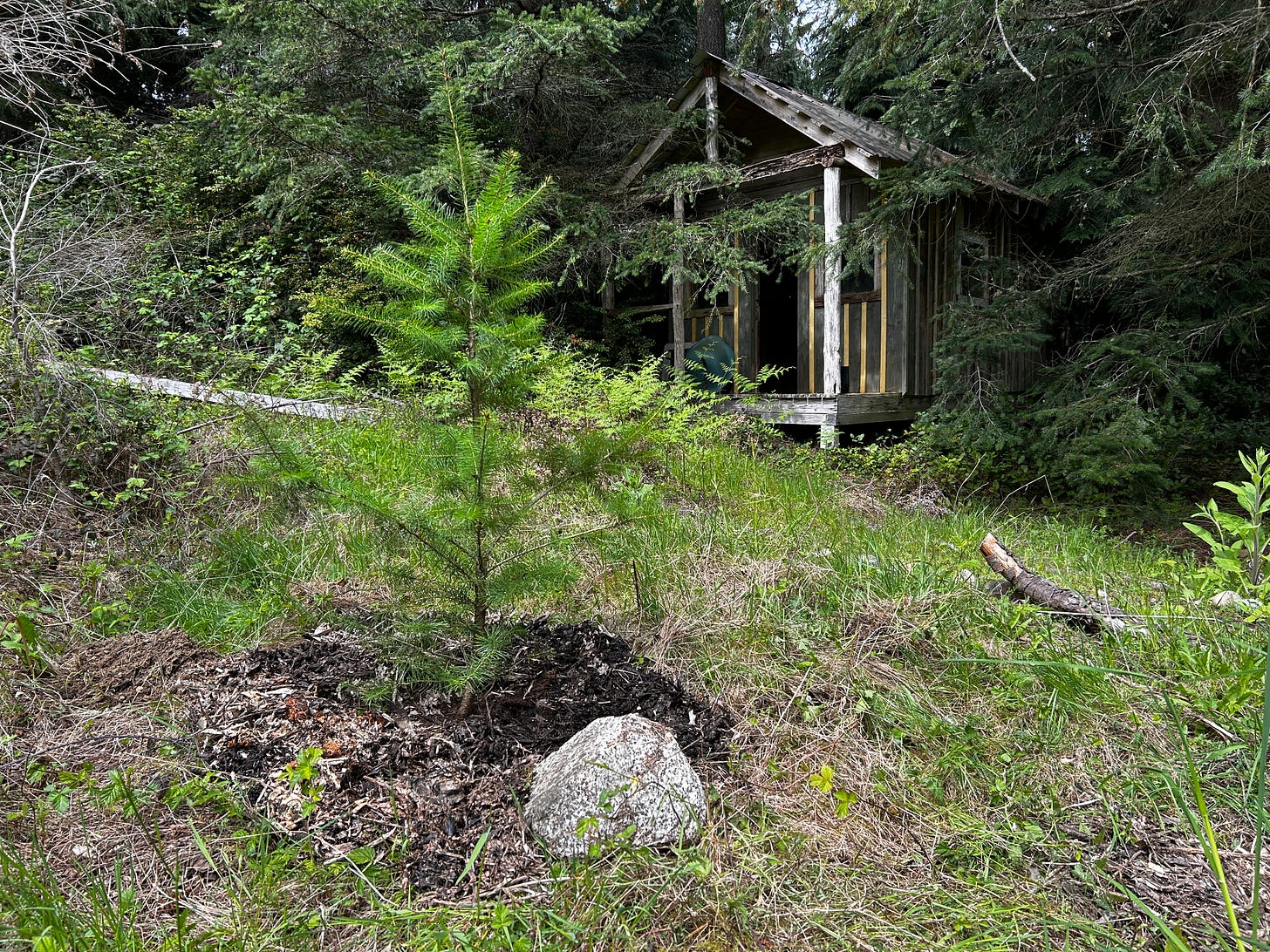A Defiant Expression of Optimism
replanting & finding home

A few weeks ago, I finally made time to plant the living tree My Beloved and I selected from a local nursery back in December. This little fella, which took more than one attempt to light properly, proved to be a darling of a Christmas tree. Nothing worthy of a Rockefeller Center ceremony, but still, a sturdy, charming house guest that had just enough heft and panache to wear even the heaviest and most intricate of ornaments with grace.
Shortly after the holiday, I de-bejeweled the tree and placed it against the fence next to a small collection of potted toddlers—all Doug firs—where they remained for the duration of winter. This murder of firs withstood buckets of rain, slashing sleet, getting knocked over by the wind, and a four-day bitter and unusual cold snap in January. Even more, they endured my complete neglect of them. While huddled together on the side of the driveway, the only real care I provided was to occasionally look their way as the dog and I ventured out for our morning walks. Occasionally, I looked at their soft, spindly and somewhat crooked branches and muttered: “Hang in there for a while.” They all did.
I really ought to have planted them back in February or March, but I’m not as hardy of a forest steward as I wish I were. Too cold? Not going out there today. Too rainy? No, thank you—there must be one more Cary Grant movie I haven’t seen. Then April came along, and well, it’s very difficult to come up with a valid excuse to not get outside and plant something in the month of April. Especially a clutch of firs that have been sitting by your garage for over four months.
After identifying some decent locations for the four smallest ones, it took me another two weeks to decide where to plant the former Christmas tree. I really wanted to get this one right. I owed it to this tree which had been such a charming presence in the house during the two darkest weeks of the year. But where to put it? If planted too deep in the woods, it might suffer from lack of light. Planted too close to the house, it could become a nuisance and a hazard.
Eventually, I landed on a spot between the large open shed and the crumbling, abandoned playhouse. But before planting, I had to prepare the area by removing as much of the bramble and thriving Himalayan blackberry starts as possible. I dream of a future where I can be surrounded by ready-to-plant garden spaces; where all my exterior domestic efforts are focused solely on the joy of putting into the ground whatever stunner I’ve just purchased at the local nursery.
Imagine a day where all the pre-prep—the weeding, mulching, soil amending, leveling, etc—could be done by some Roomba-esque device (a “Rootba”, if you will) pre-programed to pull out all the individual plants that you don’t like, after which it would rake, amend and then humbly saunter back to its Rootba Resting Station where finally it would sing out a charming little Rootba song which, translated into English, would mean something like: I have cleared the land and now you may do the magic part, my venerable Mistress!
But that day is not here yet. So, there I was, thorning the bejesus out of my pale hands in order to prepare the best, most welcome home for my charming ex-Christmas tree. From about a mile away I heard the bellow of chainsaw buzzing and the subsequent thump of massive trees hitting the ground. I could tell by the timbre and tone of their impact that these were very large trees getting cut. For hours these sounds sliced through air. In my head, I performed a kind of ecological equation: (5 three-year old trees planted) - (15 eighty-year old trees down) = ??
Like writing a poem, a story, an essay; like creating anything at all, planting a tree is a defiant expression of optimism for the future. When you hit that publish button, or give a tree its first drink of water in its new home, you’re admitting to yourself that you still believe in the goodness and resiliency of the breathing, flowering world—the vast majority of which will outlive you. These offerings, whether they be leaves, petals, stanzas or sculptures, are a confession to anyone who might listen (but mostly to yourself) that you have not given up hope in our collective survival.
The clearing down the street wasn’t much of a surprise, as I noticed the property had recently been decorated with colored ribbons and spray paint across the ground—the first signs of future development. Like many people, I moved to this island because I was enchanted by its wildness and beauty, which had still found a way to thrive alongside amenities like book stores, a movie theater, restaurants and wineries.
There still remains vast stretches of undeveloped land across the island, but there are more and more people who, like me, want to live surrounded by the disappearing wild. Growing up in the suburbs of Seattle, I became accustomed to seeing hundreds of acres of open and forested land quickly turn into housing developments named after the trees or animals that once used to live there. (Is this just an American thing—naming what we create after the thing we took down in order to build it?) Part of me is pre-conditioned to believe that all that open space I can see today will soon be replaced with a gaggle of houses painted various shades of mid-taupe and collectively referred to as “Cedar Vista.”
Discussing the recently cleared parcels all over the south end of Whidbey Island, My Beloved became a little incensed. He doesn’t like change, while I get bored easily and look forward to change. But also, it depends on the kind of change. As we were lamenting the clearing in progress two parcels over, I said to him: “Well, we can’t be those people who think it was all ok while it benefitted us but it should end right here and never benefit anyone else after us.” I know those people: I have been one of those people.
There’s an egotistical part of our brains that allows us to believe that the world is at its best right now at this moment in time, and it was made this way just for us. (And if it evolves much further, it’s all going to go to hell.) That tendency, that way of perceiving that we and we alone get to enjoy the sweet spot of the history of the universe is part survival tactic and part fear of our own insignificance. I’ve known a few people who wish they lived centuries ago but most of us do not lament missing out on what used to exist long before we came along. During all the times I indulged in the urban delights available to me in New York City, I never wished that Manhattan had remained a wild island full of flying squirrels, porpoises and birds.1
And just like Manhattan, this 10-acre piece of paradise I live on—it was all an untamed forest once. And not centuries ago. Just twenty-five years ago, there was no house, no well, no garden; no middle-aged white lady yelling at the barn swallows for shitting all over the place. But sometime in 1999, a swath of trees was removed, trucks hauled in concrete and poured it into the clay-heavy dirt. Wood from felled trees was brought in to frame and shingle a building which is now my home.
People ask me if I ever think about moving back to the city. I always say: No, I don’t. Living in the city for 25 years lighted and adorned me for many seasons, and I continue to carry the wonder that brought me where I now reside, on this woodsy patch of earth. I liken my years in the city to the two weeks that little Doug fir spent in our house, all decked out. I too was once bejeweled and much more visible than I am now that I’ve replanted myself in the woods where I have days that I don’t even bother to put shoes on. And just like me, there came the day when that ex-Christmas tree needed to relocate to where it could be closer to the mossy palaces of waxwings.
I have often thanked the person who scouted out this space and dug a hole in which I now live happily. From my house, I can look out any window and see a velvet green curtain of hemlocks, redcedars, and firs polka-dotted with hawks, owls, flickers and jays. I have never felt so at home anywhere else I’ve resided, and it would be naive and entirely selfish of me to posit that someone else shouldn’t have the opportunity to experience that same feeling when they look out whatever window they’ll be putting in their future home two parcels over. All a good life really is, is finding the right place to keep growing.
…though I do wish Flaco could have held on to his fugitive found life just a little bit longer.
【HHH】 This content has been certified as human-created by Authograph.





I never cease to be amazed by your wisdom, delighted by your humor, and moved by your visions. 💚